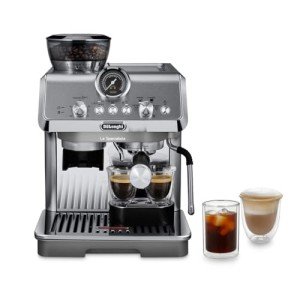The Rise of Home Espresso Machines: A Comprehensive Guide
As coffee enthusiasts continue to seek fresh and tasty brews in your home, the popularity of home espresso machines has surged in recent years. No longer just the domain of cafes and coffee stores, these machines empower people to craft barista-quality espresso drinks from the comfort of their kitchens. This article will explore the various kinds of home espresso machines, their features, and factors to consider for picking the best one. In Espresso Machines For Sale , it will provide a choice of FAQs to help potential purchasers make informed choices.
Types of Home Espresso Machines
Home espresso machines can be classified into several categories based on their systems and user-friendliness. Each type has its unique features, pros, and cons.
| Type | Description | Pros | Cons |
|---|---|---|---|
| Manual Espresso Machines | Requires the user to by hand manage the developing process, involving methods like pulling a lever to produce pressure. | - Complete control over brewing procedure - Compact style | - Requires ability and practice - Time-consuming |
| Semi-Automatic Machines | Machine automates water flow and pressure, however the user still controls the dosing and period of the brewing procedure. | - Balance of automation and control - Versatile | - Learning curve for refining methods |
| Totally Automatic Machines | Automates the whole developing process, from grinding to developing, often with programmable settings for personalized beverages. | - Extremely user-friendly - Quick and practical | - Less control over the brewing process - Higher cost point |
| Pill or Pod Machines | Utilizes pre-packaged espresso capsules or pods to create coffee rapidly and easily. | - Extremely easy to use - Minimal cleanup | - Limited taste range - More pricey per cup than ground coffee |
| Super-Automatic Machines | Integrates functions of fully automatic machines with built-in mills, enabling users to brew whole bean espresso and milk-based beverages with one touch. | - All-in-one convenience - Ideal for milk-based beverages | - Often the most pricey - Can be large |
Features to Consider
When choosing a home espresso machine, prospective buyers need to think about the following functions to guarantee they pick a machine that satisfies their needs:
Grinder Type:
- Built-in grinders can provide fresher grounds but may require more maintenance.
- Separate grinders permit more personalization of grind size.
Pressure:
- Look for machines that produce at least nine bars of pressure, which is ideal for developing espresso.
Water Temperature Control:
- Machines with adjustable temperature settings enable better extraction of flavor from beans.
Milk Frothing Options:
- Consider whether you want a manual steam wand for frothing or an automatic milk frother for convenience.
Relieve of Cleaning:
- Machines with detachable parts and self-cleaning functions considerably minimize cleanup time.
Size and Design:
- Ensure the machine fits comfortably in your cooking area and lines up with your aesthetic preferences.
Budget:
- Set a budget before starting your search, as rates can vary significantly from affordable models to high-end machines.
Benefits of Home Espresso Machines
Owning a home espresso machine offers various benefits:
- Cost-Effective: Over time, developing espresso in the house can conserve coffee lovers cash compared to frequent café sees.
- Personalization: Users can explore various beans, grind sizes, and brewing strategies to discover their best cup.
- Convenience: The ability to brew espresso at any time removes the need to head out to a café, especially advantageous throughout late nights or mornings.
- Quality Control: With a home machine, people have complete control over the quality of components and developing processes.
Drawbacks of Home Espresso Machines
Nevertheless, there are some drawbacks to consider:
- Initial Investment: High-quality espresso machines can be pricey, needing a considerable in advance investment.
- Knowing Curve: Mastering the art of espresso brewing can require time and practice, which might be daunting for beginners.
- Maintenance: Like any device, espresso machines need regular cleaning and maintenance to ensure ideal performance.
Frequently asked questions
1. What is the best type of home espresso machine for beginners?
Answer: For beginners, a semi-automatic machine is frequently suggested as it uses a balance in between control and automation, permitting you to find out the fundamentals without frustrating intricacy.
2. How much should I invest in a home espresso machine?
Response: Entry-level machines can begin around ₤ 100 to ₤ 300, while higher-end designs can vary from ₤ 500 to over ₤ 2000. It's vital to set a budget based upon your anticipated usage and wanted functions.
3. Do I need a different grinder?
Answer: While some espresso machines come with integrated mills, investing in a separate grinder enables greater modification and ensures much better quality premises.
4. How often should I clean my espresso machine?
Answer: Cleaning frequency can differ by machine type, however it's normally recommended to clean up the machine after each use and carry out deep cleanings weekly or regular monthly, depending on usage.
5. Can I make milk-based beverages with any espresso machine?
Answer: Not all machines feature milk frothing capabilities. If you take pleasure in beverages like lattes or cappuccinos, search for a machine with a steam wand or automatic frother.
Home espresso machines are changing the way coffee aficionados enjoy their precious brews. With numerous types and advanced functions offered in the market, there is something for everybody. Whether it's the pleasure of developing special recipes or merely appreciating the best shot of espresso, investing in a home espresso machine can enhance both the coffee-drinking experience and the quality of life for coffee fans everywhere. Just like any investment, it is crucial to weigh the benefits against the possible downsides and choose a machine that effortlessly fits both your lifestyle and preferences.

